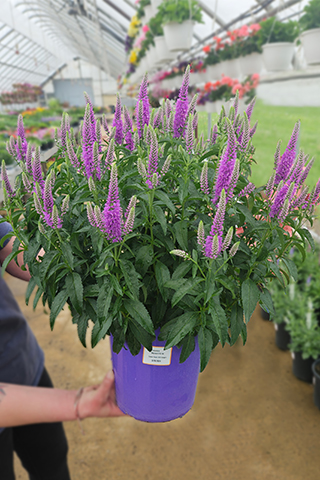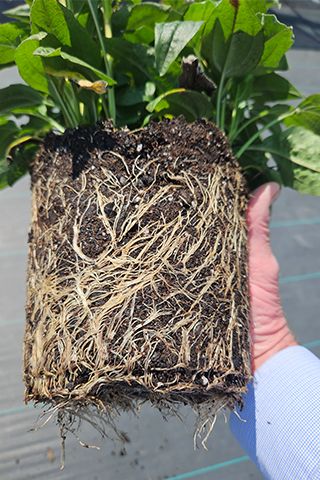7/31/2025
Perennials Section: Overwintering vs. FYF Perennials: What’s Right for Me?
Chris Fifo

With my roots in growing perennials for the majority of my career—and much of that time growing liners for overwintering—I used to cringe when I heard the industry refer to “annualizing” perennial production. After all, the cold-treated perennial plug was the bulk of our business, and if someone wanted to grow a perennial like an annual, that would cut into our sales.
First-year-flowering Veronica Skyward shows optimum performance—accurately scheduled for retail.
But now, being on the breeder and promotional side of the industry, I have a completely different perspective. This notion of “annualizing” perennials, I feel, is responsible for the explosion in perennial popularity. And advancements in breeding have made it much easier to grow and schedule perennials to full flower without the need for overwintering.
But vernalized liners, spring-planted perennial liners and fall-planted/overwintered finished containers are all still very popular programs.
Three different philosophies for growing a flowering crop of perennials might lead you to wonder, “Why would I choose one program over the other? When should I overwinter and when should I annualize?” Let’s dig into it a bit.
An argument for overwintering crops
While much work has been done on perennials, there’s a set of perennials that breeders haven’t yet cracked the code on for juvenility and that require vernalization for full flowering. Most of these are early spring flowering crops, including phlox, iberis, aubrieta and aquilegia. These are best overwintered in finished containers.
For successful vernalization with the least amount of loss, growers need to allow plenty of time in the fall to get a full, well-rooted container. This means transplanting in July to September, depending upon your region. This often catches growers off guard. Taking advantage of summer temperatures, light levels and photoperiod gives the greatest maturity. Once we get into September, these advantages are quickly lost for some perennials.
In addition to these perennials that require vernalization, many growers choose to grow their entire perennial program with traditional scheduling. There are definite advantages to doing this, such as:
- Many perennials will have greater vigor, fill the pots better and have superior flowering (such as Salvia nemerosa).
- Some will flower earlier after vernalization (such as achillea, monarda and penstemon).
- Often, there’s more labor and space available for summer planting.
- Come next season, the perennial program is in the ground, allowing growers to focus on annuals needing to be planted.
 While many perennials will continue to grow and mature as long as temperatures are suitable, you need to be aware of long-day perennials. This assortment includes Phlox paniculata, asclepias, echinacea and rudbeckia. These must be fully mature and established before Week 38. At this time, they’ll begin to go dormant from short days and no more top growth can be achieved under natural conditions. Instead they’ll begin to draw energy from the leaves into the crown and roots. (Note: This is why you shouldn’t trim the foliage until the plant is completely dormant.)
While many perennials will continue to grow and mature as long as temperatures are suitable, you need to be aware of long-day perennials. This assortment includes Phlox paniculata, asclepias, echinacea and rudbeckia. These must be fully mature and established before Week 38. At this time, they’ll begin to go dormant from short days and no more top growth can be achieved under natural conditions. Instead they’ll begin to draw energy from the leaves into the crown and roots. (Note: This is why you shouldn’t trim the foliage until the plant is completely dormant.)
Keep in mind that even the best growers will experience losses in overwintering. This is obviously one of the greatest disadvantages. Also, it’s often difficult to schedule spring flowering using this method. Fall-planted perennials will generally come out of dormancy and flower when they want to, which may make it difficult to hit the desired foot traffic at retail.
A strong perennial root system ready for vernalization.
Why choose vernalized?
Another opportunity to get some of the advantages of overwintering without the risk and time is to start with a vernalized liner. This is a great option for many varieties.
When starting with a vernalized liner, size matters. The larger the better for the best and fastest finish. I usually recommend 50-plug or larger. It’s important that it’s completely dormant at the time of planting. For one thing, there’s much less risk of cold damage in January and February when these would normally be shipped. Plus, once the liner breaks dormancy the clock is ticking towards flowering. If you begin to get too much growth in the liner it will have a difficult time filling out the container before going to flower.
Another advantage of the vernalized liner is that they’re relatively easy to schedule for flowering. Some suppliers offer this information along with cultural recommendations for success. This usually involves breaking dormancy quickly with warm temperatures (65F/18C-plus) and using long-day lighting on necessary varieties (long-day perennials, as mentioned earlier).
Vernalized liners will often cost a bit more due to the production time involved, but I feel it’s often worth it. Be aware of some of those early spring bloomers, though. Some tend to go to flower so quickly they may not fill out a trade gallon pot very easily. Or consider a hybrid program where you fall-plant early spring items and use vernalized liners for the rest.
A case for FYF
Which brings us to the more modern approach to perennial production—first year flowering (FYF). This program has revolutionized perennial production and the perennial market, in general. Advancements in breeding techniques have not only brought better-performing perennials to the consumer and landscape markets, but it has also brought great benefits to the growers.
Author’s note: One thing I’d like to point out about perennial breeding is that it’s still done by traditional methods, not via GMOs. We make educated crosses of two plants, collect and grow the seeds, then evaluate what we get. By repeating this process over and over breeders are able to continuously select for specific traits. One of our breeders commented, “It’s like a treasure hunt looking for that one plant with the perfect habit and performance.”
Yes, it’s a slow process. But once found, that perfect plant can be cloned relatively quickly via tissue culture and—voilà!—we have a new perennial for the market.
Plant vigor is a primary goal in breeding for FYF. Since many perennials have more vigor after overwintering that needs to be matched without chilling. Check.
Since many perennials have greater flower power after overwintering that needs to be matched without chilling. Check.
Since many perennials flower earlier after overwintering that needs to be matched without chilling. Check.
And, since it can be difficult to control the flower timing with a fall plant, we need to make it easy for growers to schedule their perennials to flower from an actively growing liner. This is high priority for all parties involved in bringing new FYF perennials to market. We all know color sells, so we have to have the color when we have the foot traffic.
To make it easier for growers to accomplish this, a vast amount of culture and scheduling trials are done prior to introducing a new FYF perennial. This involves planting the same age liners every two to three weeks and collecting data for spring, summer and fall flowering.
The most important flowering information and timing gathered is what I would call “retail ready.” For many perennials, that’s at about 50% full flower.
For years, this valuable data has been provided to growers via grower facts sheets or technical/cultural documents from breeders for each variety. But this has proven to be quite inconvenient when it comes to an entire perennial program.
To ease the burden of having to check all of those sheets to schedule a program, this data for first-year flowering perennials from Darwin Perennials and PanAmerican Perennials has now been compiled into an online tool called FirstYearFloweringTool.com.
This easy-to-use tool will help you choose FYF perennial varieties for your needs, help you schedule for the week you want them to flower and provide all of the cultural information necessary to grow a premium quality perennial program.
Check.
Whichever production route you choose for your perennial program, don’t forget to consult resources to avoid unforced errors and to have peak perennial color when your customers are looking for it. GT
Chris Fifo is a product representative for Darwin Perennials and PanAmerican Seed Perennials.